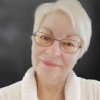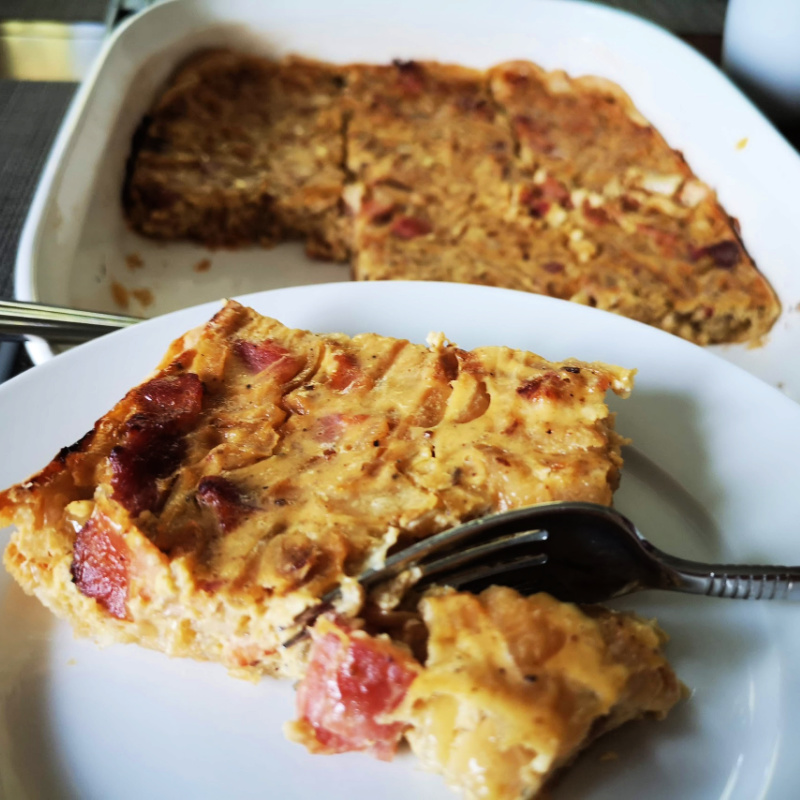- Home
- German Food Guide
- Caramelized Onion Tart
Zwiebelkuchen Recipe: German Caramelized Onion Tart
By: Gerhild Fulson / Using her extensive experience and cultural knowledge, Oma Gerhild provides trusted, authentic, and easy-to-follow German recipes both here and in her many cookbooks.
Zwiebelkuchen, is one of my favorite traditional German recipes. This German onion cake (onion cake is the literal translation of Zwiebelkuchen) features caramelized onions as the main ingredient, along with smoky bacon, sour cream, and caraway seeds. All of these are mixed together into an absolutely delicious custard and then poured into a pastry dough and baked until golden brown.
The result? A hearty and flavorful dish that makes you go "Mmmmm!" with every delicious bite!
My first taste of this was on my first trip back to Germany, way back in 2006, after having left Germany in 1953 as a toddler. Mutti never made a Zwiebelkuchen recipe, at least that I can recall. She was from Berlin and this savory onion pie hails from the Swabia (Schwabian) region in the state of Baden-Württemberg in southern Germany. Although now it is popular all over Germany!
I remember thinking when I first bit into that slice of schwäbischer Zwiebelkuchen, "Oh, what a treat! Yummy, creamy with a crispy buttery crust. I've GOT to get this recipe and make it once I'm home!"
I was excited to add this wonderful Caramelized Onion Tart recipe to my repertoire of yummy German recipes.
What does a German Caramelized Onion Tart taste like?
You may think very onion-y. Nope, not at all. The process of caramelizing the onions brings out their natural sugars, resulting in golden brown onions that are mild, a wonderful blend of savory and sweet, and melt-in-your-mouth tender.
What you end up with is a German onion pie that is savory, rich, and creamy, with a touch of sweetness from the onions and a bit of smokiness from the bacon. This is truly German comfort food that will have your taste buds dancing with joy!
So if you're not a huge fan of onions, have no fear. I've served this delicious savory pie to people who don't like onions at all (such as my hubby). All loved it, and my granddaughter, Lydia, said it sort of reminded her of cabbage (and she doesn't like onions at all but loves cabbage!).

A tiny bit of Zwiebelkuchen history
The original Zwiebelkuchen recipe hails from the Swabian region in the state of Baden-Württemberg, a place well-known for its traditional cuisine.
No one knows how long this recipe's been in existence, but it is likely centuries old; the use of seasonal ingredients in creating hearty dishes is a deep-rooted and long-standing German tradition.
Fall traditions
Fall is a favorite time of year for many people as the hot summer days transform into cooler weather. It is a wonderful time of the year with the breathtaking scenery of the changing foliage, harvest and cultural celebrations, an overall sense of coziness, and of course, seasonal dishes that bring warmth and comfort.
One of those seasonal dishes is Zwiebelkuchen. It is often served in the fall months, which happens to coincide with the onion harvest. Not only does it coincide with the onion harvest, but with the grape harvest as well.
Zwiebelkuchen plays a big part in fall-time celebrations, two of which are Oktoberfest and wine festivals. That's because this German caramelized onion tart pairs perfectly with a glass of wine. New wine, to be exact.
When I first tasted Zwiebelkuchen, I had it with its traditional drink, a glass of Federweisser.

Federweisser is a young wine that is made from freshly-pressed white wine grape juice. It is a young wine because it is available shortly after the grape harvest and it is still fermenting.
It's a lightly sparkling wine that is known for its sweetness and fruity notes and is often paired with other fall-time favorites like pretzels, Bratwurst and other German sausages, and of course, Zwiebelkuchen and other savory tarts. As you can see, it is a very popular drink during autumn celebrations.
And now, the Zwiebelkuchen recipe is made throughout Germany, especially in the wine-producing regions. Why? Because it fits so perfectly with that glass of Federweißer! It truly is a seasonal treat!
Puff pastry or yeast dough?
The recipe I am sharing with you is an easy version of the authentic Zwiebelkuchen. Why? Traditionally, it is made with a yeast dough, which is time-consuming and requires more work. I prefer to use frozen puff pastry, which makes quick work of this German caramelized onion tart without sacrificing flavor.
Puff pastry is a layered pastry that is light and flaky and buttery. Purchased from the grocery store, it just needs to be thawed and rolled out, and it's ready to go. A yeast dough is heartier and more time-consuming, as it needs time to rise.
While different from a yeast dough, puff pastry is a perfect alternative base for that deliciously traditional custard filling.
Varieties of Zwiebelkuchen
There aren't too many variations of this delicious German onion pie. It basically comes down to whether you prefer:
- yeast dough or puff pastry
- sour cream or heavy cream
- nutmeg and/or caraway seeds or none at all
Some recipes may call for cheese. For a vegetarian version, simply omit the bacon. You can always try adding smoked tofu.
Flammkuchen, which translates to flame cake or tarte flambée, can be seen as a regional variation. They are not the same, but have many similarities.
What is the difference between Zwiebelkuchen and Flammkuchen
Flammkuchen is also an onion tart, but resembles more of a pizza. It is lighter and more delicate, has a thinner, crispier crust and is usually topped with creme fraiche, caramelized onions, and diced bacon. Below, I've made my Flammkuchen with caramelized onions, bacon, and sliced asparagus. Instead of the usual creme fraiche, I used Greek yogurt. Yum!
On the other hand, Zwiebelkuchen has more of deep-dish style with a thick and creamy custard filling that resembles more of a quiche. (In fact, apart from the onions, it is similar to the famous Quiche Lorraine!) It is rich and hearty and has a yeast dough or puff pastry base.
The original Zwiebelkuchen recipe comes from the Swabian region of Baden-Württemberg.
Flammkuchen originates from Alsace, a region in northeastern France, but is very popular in Baden-Württemberg with which it shares a border.
As a matter of fact, for centuries the region of Alsace has passed back and forth between French and German control, which is why it is highly influenced by both French and German culture.
How to make Zwiebelkuchen, the savory German onion pie
The Zwiebelkuchen recipe I am sharing with you today is from my dear friend Heidi. Although she's not from Baden-Württemberg, she has family that lives there and visits often.
Ready to get started on this delectable adventure? The aromas that are about to fill your kitchen are just heavenly!
Start by gathering all your ingredients.

Once you've preheated your oven to 395 degrees F and greased a 10½ x 13-inch baking pan, dice the bacon into small pieces.

Add the bacon pieces to a frying pan over medium-high heat. You'll want to cook the bacon until it starts to render its fat and gets a little browned. Transfer the cooked bacon to a separate dish, leaving the fat in the pan.

Now slice the onions and add them to the bacon fat in the frying pan. Cook the sliced onions over medium heat, stirring every once in a while, until they become translucent and a beautiful golden brown. This process will take about 15 minutes.

Add the bacon to the cooked onions, stir, and set aside to cool.

Now, to release and enhance their flavor, slightly chop the caraway seeds.
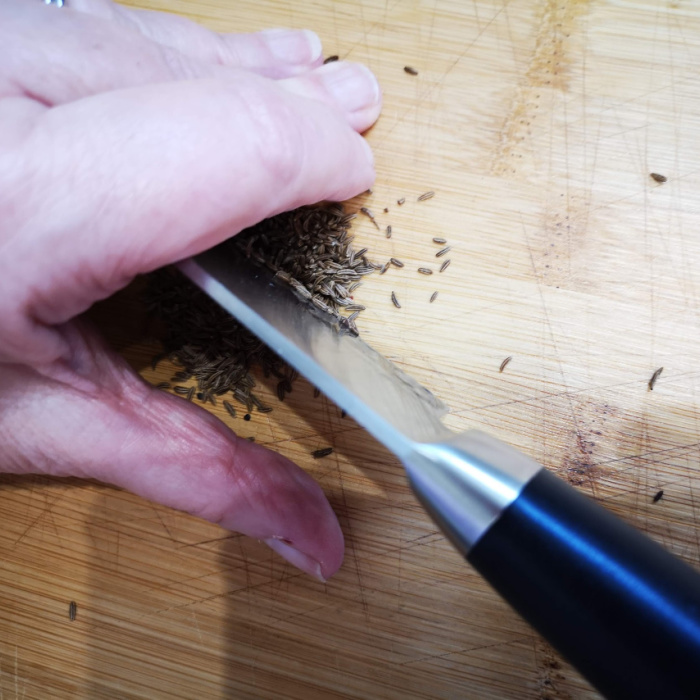
Grab a large mixing bowl and add to it sour cream, a little flour, 4 eggs, a little nutmeg, salt, pepper, and the chopped caraway seeds. Whisk it all together until it is very well mixed and set aside.
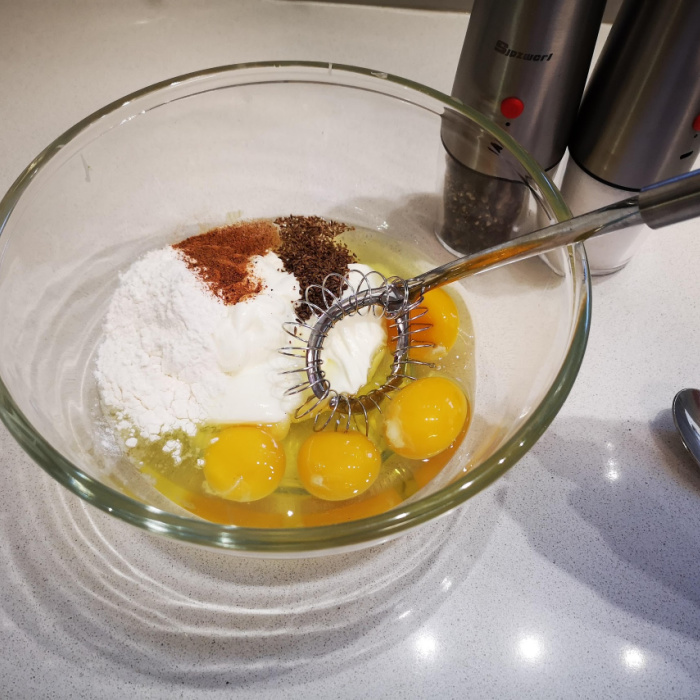
Now, time to prepare the puff pastry!

On a sheet of parchment paper, roll out the thawed puff pastry. Lift up the parchment paper with the pastry on it and flip it over into your prepared baking dish or tart pan. Remove the parchment paper and press the dough down and up the sides of the dish, creating a rim.
Pierce the dough all over with a fork. Place the dish in the fridge until the onion and bacon mixture has cooled and you are ready to fill it.
Now the fun really begins! This is where you get to see it all come together into a beautiful creation.
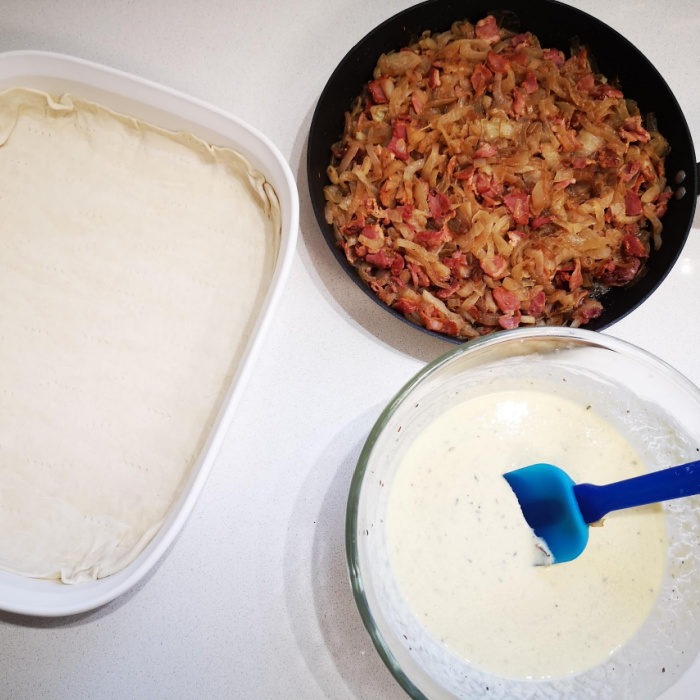
Start by stirring the onion and bacon mixture into the sour cream mixture until it is well mixed.

Next, pour the custard filling over the puff pastry in the baking pan and smooth out the top.
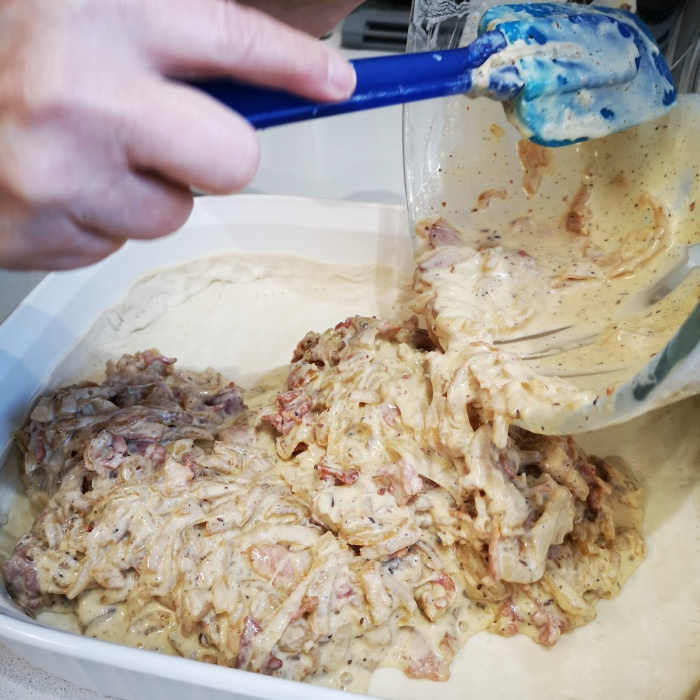
Now we're ready for the oven! Place your dish in the preheated oven and bake for about 40 minutes.
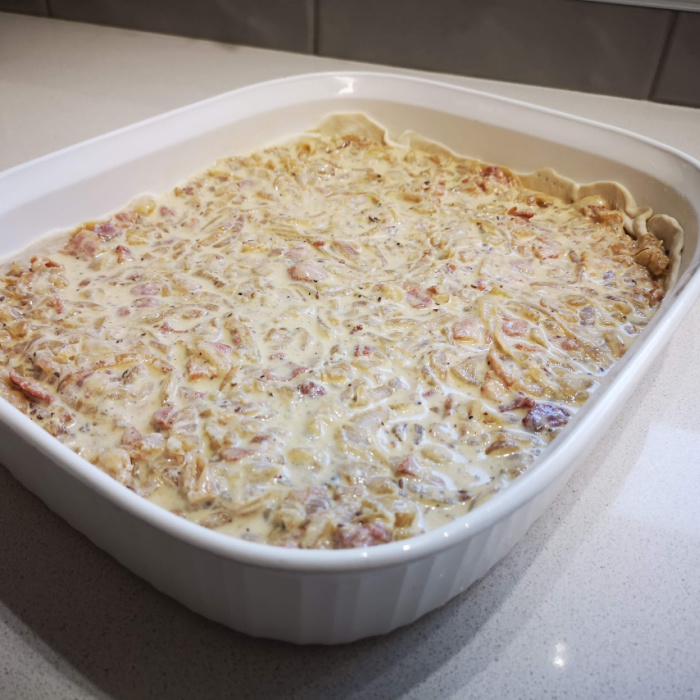
Once the top is nice and golden brown, remove it from the oven and let it stand for about 10 to 15 minutes.

Finally, time to cut into this wunderbar German caramelized onion tart and enjoy the fruits of your labor. Yum!

NOTE: I used a 10½ x 13-inch casserole dish to make this recipe. However, my friend Heidi used a 10½ x 16-inch baking pan. This is how hers turned out:

So even if you don't have the same size baking dish, you can still enjoy this wonderful Zwiebelkuchen recipe. The only difference is you may have to adjust the baking time.

How to serve this savory German onion tart
Zwiebelkuchen is best served warm and makes a great dinner served with a green salad on the side and a glass of Federweisser. Can't get Federweisser? Don't let that stop you from enjoying this traditional schwäbischer Zwiebelkuchen! It also goes great with a spritzer of sparkling water mixed with white grape juice. Or serve with your favorite wine.
Zwiebelkuchen is also wonderful for lunch, as part of a brunch buffet, or cut into smaller pieces and served as an appetizer.
More recipes from Baden-Württemberg
Want more recipes enjoyed in this region of Germany? Check out these yummy recipes:
- German Asparagus Salad
- German Asparagus Soup
- White Asparagus with Easy Hollandaise Sauce
- Cheese Spätzle
- Flammkuchen
- Black Forest Cake
Now, time to make this delicious German onion pie recipe!!
Zwiebelkuchen Recipe: German Caramelized Onion Tart
This is an easy version of the authentic Zwiebelkuchen, which is traditionally made with a yeast dough. Using frozen puff pastry makes quick work of this savory German onion tart. Perfect for weeknight meals or special occasions!
Prep Time25 minutes |
Cook Time1 hour |
Total Time1 hour 25 minutes |
Servings:
Makes 8 servings
Ingredients:
- 1 package (about 375 grams) thick-cut bacon
- 2 pounds (about 900 grams) yellow onions
- 1¼ cups (300 grams) sour cream
- 1 tablespoon all-purpose flour
- 4 large eggs
- ¼ teaspoon nutmeg
- ¼ teaspoon freshly ground black pepper
- ½ teaspoon salt
- 1 teaspoon caraway seeds
- 1 package (about 400 grams) frozen puff pastry, thawed
Instructions:
- Preheat the oven to 395°F (200°C) and lightly grease a 10½ x 13-inch casserole dish (or similar size rimmed baking sheet).
- Dice the bacon slices. In a large frying pan over medium-high heat, cook the bacon until the fat starts to render and the bacon just starts to get browned. Remove to a dish, keeping the rendered fat in the pan.
- Slice the onions and add them to the frying pan. Over medium heat, slowly cook the onions, stirring occasionally, until they become golden and translucent. This will take about 15 minutes. Stir in the bacon and set aside to cool.
- Meanwhile, in a large bowl, add the sour cream, flour, eggs, nutmeg, pepper, and salt. Chop the caraway seeds slightly before adding them to the bowl. Whisk together until well mixed.
- Roll out the thawed pastry on parchment paper. Lifting it with the parchment paper, flip it over into your prepared baking dish. Peel off the parchment paper and press the pastry about one inch up the sides of the dish, creating a rim. Using a fork, pierce the dough all over. Place in the fridge to keep it cold until you are ready to fill it.
- Once the bacon and onion mixture has cooled, stir it into the sour cream mixture until it is well mixed.
- Pour the filling into the pastry-lined casserole dish, smoothing out the top.
- Place in the preheated oven and bake for about 40 minutes, until the top is nice and golden brown.
- Let it stand for about 10 to 15 minutes to cool before cutting and serving.
Notes/Hints:
- Yellow onions are most common in Zwiebelkuchen, but you can use other varieties, such as red onions, or whatever you may have on hand.
- You can use a 10½ x 16-inch roasting pan. The Zwiebelkuchen won't be quite as thick, but it's yummy just the same. It will take a few minutes less to bake. You can also try using a springform pan with a removable bottom for a round Zwiebelkuchen.
- You can substitute heavy cream for the sour cream.
- Store any leftovers in an airtight container in the refrigerator. German onion pie tastes just as good the next day!
* * * * *
Unless otherwise noted recipe, images and content © Just like Oma | tourmygermany.com
Zwiebelkuchen Recipe: German Caramelized Onion Tart
By Oma Gerhild Fulson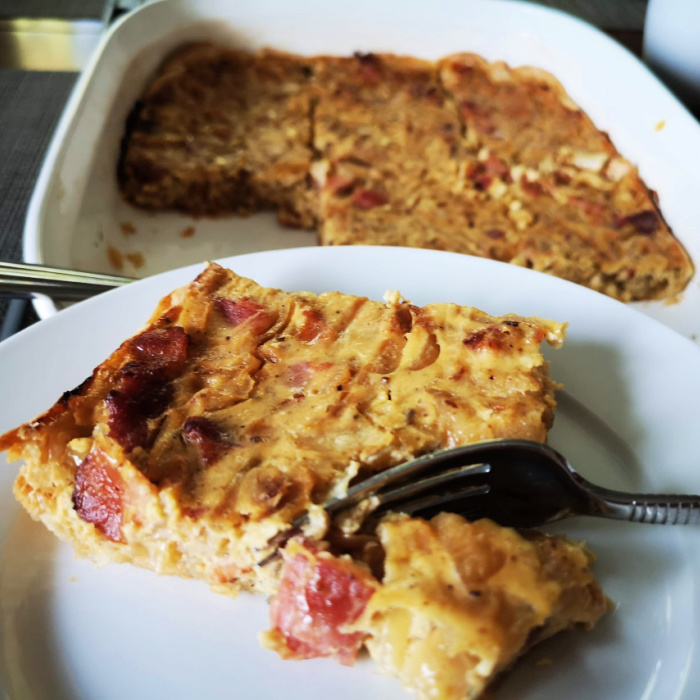
Savor this caramelized onion tart from Baden-Württemberg. Our Zwiebelkuchen recipe combines caramelized onions, bacon, sour cream, and caraway seeds. Lecker schmecker!
Ingredients: bacon, onions, sour cream, flour, eggs, nutmeg, pepper, salt, bay leaf, caraway seeds, frozen puff pastry
For the full recipe, scroll up ...
